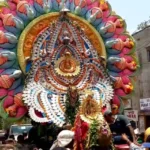Introduction:
Basant Panchami, also known as Saraswati Puja, is a vibrant Hindu festival that marks the arrival of spring. Celebrated on the fifth day (Panchami) of the bright fortnight (Shukla Paksha) in the Hindu month of Magha, Basant Panchami holds a special place in the hearts of devotees across India. This festival is dedicated to the goddess Saraswati, the embodiment of knowledge, music, arts, and wisdom. In this article, we will explore the cultural, religious, and spiritual dimensions of Basant Panchami, uncovering the rituals, mythology, and the transformative essence associated with this joyous occasion.
Cultural Significance of Basant Panchami:
Basant Panchami, translating to “spring’s fifth day,” is a celebration of nature’s awakening after the winter slumber. The festival is synonymous with the blossoming of vibrant yellow flowers, especially the sarson (mustard) flowers, which blanket the fields. The color yellow is symbolic of prosperity, knowledge, and the vibrancy of life.
In many regions, Basant Panchami is considered an auspicious time to initiate new ventures, engage in cultural activities, and seek the blessings of the goddess Saraswati for academic pursuits. Schools, colleges, and educational institutions often organize special events and prayers on this day, honoring the goddess of learning.
Religious Significance and Mythology:
Basant Panchami holds immense religious significance, primarily dedicated to the worship of Goddess Saraswati. Saraswati is one of the Tridevi, the triad of Hindu goddesses, along with Lakshmi and Parvati. She is revered as the embodiment of wisdom, creativity, and the arts.
The festival also coincides with the seasonal shift from winter to spring, signifying the triumph of warmth and light over the cold darkness. The association of Saraswati with Basant Panchami underscores the connection between the goddess and the transformative power of knowledge that dispels the darkness of ignorance.
Mythology surrounding Basant Panchami is often linked to the divine narratives involving Saraswati. One popular legend narrates the creation of Saraswati by Lord Brahma. According to the myth, Lord Brahma felt the need for a goddess who could personify knowledge and arts. He created Saraswati from his own essence, endowing her with unparalleled wisdom and grace.
Another tale relates Saraswati’s association with the great sage Vedavyasa. Saraswati played a pivotal role in assisting Vedavyasa in compiling the Vedas, the ancient sacred texts of Hinduism. The goddess is often depicted seated on a white lotus, symbolizing purity, with a veena (musical instrument) in her hands, representing the harmonious blend of knowledge and the arts.
Rituals and Observances:
Basant Panchami is marked by various rituals and observances that highlight the reverence for Goddess Saraswati and the celebration of spring:
- Puja and Prayer: Devotees perform special pujas (ritual worship) dedicated to Saraswati. Temples, educational institutions, and homes witness elaborate ceremonies involving the decoration of the goddess’s idol with yellow flowers, offering of sweets, and recitation of hymns and mantras.
- Saraswati Vandana: The recitation of Saraswati Vandana, a hymn dedicated to the goddess, is a common practice on Basant Panchami. Devotees seek Saraswati’s blessings for academic success, creativity, and the pursuit of knowledge.
- Yellow Attire and Decorations: Wearing yellow attire is considered auspicious on Basant Panchami, symbolizing the vibrancy of spring and the blossoming flowers. Homes and institutions are adorned with yellow decorations, creating an atmosphere of joy and festivity.
- Initiation of Learning: Basant Panchami is often chosen as an auspicious day to initiate young children into the world of learning. Many children begin their formal education on this day, seeking Saraswati’s blessings for academic excellence.
- Cultural Performances: Schools and colleges organize cultural programs, featuring music, dance, and other artistic expressions. These performances pay homage to Saraswati and celebrate the creative spirit that she embodies.
- Kite Flying: In some regions, kite flying is a popular activity during Basant Panchami. The sky is adorned with colorful kites, symbolizing the arrival of spring and the playful spirit of the season.
Transformative Essence of Basant Panchami:
Basant Panchami encapsulates a transformative essence that extends beyond the rituals and celebrations. Here are some aspects that contribute to the profound significance of the festival:
- Knowledge and Wisdom: The worship of Saraswati on Basant Panchami signifies the pursuit of knowledge and wisdom. The goddess is invoked to bless devotees with clarity of thought, intellect, and the ability to discern right from wrong.
- Creativity and Arts: Saraswati is the patroness of creativity and the arts. Basant Panchami serves as a reminder of the importance of fostering creativity in all its forms, whether in literature, music, dance, or any other artistic expression.
- New Beginnings: The festival, occurring during the transition from winter to spring, represents a period of renewal and new beginnings. Devotees use this auspicious time to initiate positive changes in their lives, embark on new ventures, and set educational or artistic goals.
- Cultural Harmony: Basant Panchami brings people together through cultural celebrations, fostering a sense of unity and harmony. The festival transcends religious and regional boundaries, emphasizing the shared appreciation for knowledge, arts, and the beauty of spring.
- Connection with Nature: The vibrant yellow hues of Basant Panchami are a celebration of nature’s beauty. The festival encourages individuals to connect with the natural world, appreciating the blossoming flowers, the warmth of the sun, and the sense of rejuvenation that spring brings.
- Symbolism of Yellow: The color yellow, predominant in Basant Panchami celebrations, symbolizes optimism, joy, and enlightenment. It reflects the radiance of the sun and the energy of life, inspiring individuals to embrace positivity and hope.
Conclusion:
In conclusion, Basant Panchami is a festival that harmoniously blends cultural, religious, and spiritual dimensions. Through the worship of Goddess Saraswati and the celebration of spring, devotees find inspiration to pursue knowledge, foster creativity, and embrace new beginnings.
As the yellow blossoms of mustard fields and marigold flowers adorn the landscape, Basant Panchami becomes a canvas of joy, symbolizing the vibrant tapestry of life. The transformative essence of the festival lies in its ability to evoke a sense of renewal, both within individuals and in the collective consciousness, as they welcome the arrival of spring with reverence and celebration.








